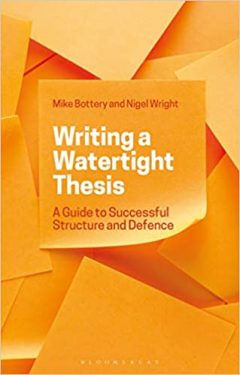Review: Writing a Watertight Thesis

Writing a Watertight Thesis
A Guide to Successful Structure and Defence
By Mike Bottery and Nigel Wright
Bloomsbury Academic, 2019
One of the most challenging aspects of writing a thesis is deciding how to plan and structure its various components. This is precisely the focus of Writing a Watertight Thesis by Mike Bottery and Nigel Wright. According to the authors, this guide explains “how to set up a thesis structure and how to maintain it throughout the doctoral journey.”
Though using terminology common at UK universities, the authors emphasize that their approach is nonetheless “helpful under most doctoral rubrics whether the research takes place in the UK, Hong Kong, Canada, the Czech Republic, or in most other countries.”
The other claim to wide applicability is related to the approach itself. Bottery and Wright indicate that their formula would work for all doctoral students, irrespective of discipline. All doctoral students do stand to receive some benefit from reading this guide, but this claim is somewhat questionable given that the formula presented here is clearly influenced by approaches typically used in the social sciences.
The key to their approach is building a thesis structure based on the research questions and sub-questions. Using the research questions as the main structuring principle would lead to sound arrangement of the thesis components, thus ensuring that all components are linked effectively. This formula is perhaps most beneficial in that it draws attention to an all-too-common pitfall: a thesis structure characterized by logical leaps, one lacking in cohesiveness and synthesis.
If you follow their formula, the authors promise, you will produce a watertight thesis which cannot by sunk by examiners—at least not on structural grounds. This approach, it must be mentioned, seems mechanical and highly restrictive. The authors clearly favour tried and tested (read: safe) approaches over creative or innovative ones. While the approach could be described as rigid or limiting, it is still possible to use this book to learn basic structuring principles and then divert from those principles as you see fit.
The above is especially true for those who know little about thesis planning and writing. The authors neither assume that the reader has much prior knowledge, nor do they shy away from addressing the most basic elements of thesis writing such as constructing good research questions, the different epistemologies informing how researchers view knowledge production, and the positionality of the researcher. In addition, they discuss best practices with respect to writing literature reviews and methodologies.
The chapters of Writing a Watertight Thesis move chronologically—from the proposal to the defence and beyond. While this is definitely a good guide to consult no matter where you happen to be on that chronological arc, it is best to do so alongside other guides which provide more flexible and innovative approaches.